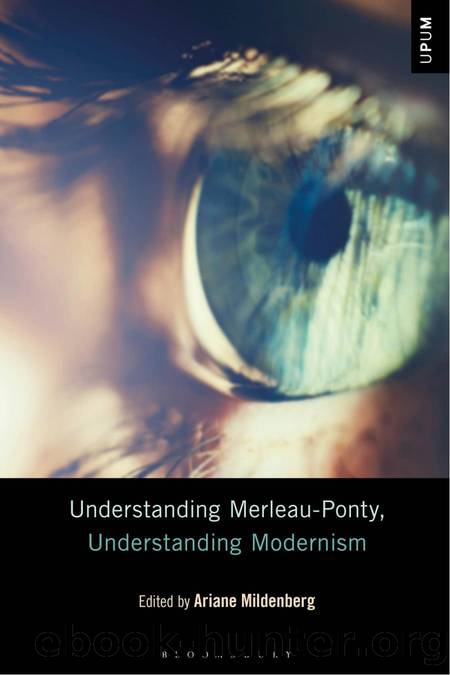Understanding Merleau-Ponty, Understanding Modernism by Ariane Mildenberg;

Author:Ariane Mildenberg;
Language: eng
Format: epub
ISBN: 9781501302725
Publisher: Bloomsbury USA
Published: 2019-11-24T00:00:00+00:00
12
Motricité, Physiology, and Modernity in Phenomenology of Perception
Mark Paterson
Introduction
In the first four chapters of Part One of Phenomenology of Perception, Maurice Merleau-Ponty outlines the limitations of mechanistic physiology and classical psychology which leads him to consider, via the infamous neurological case study of Johann Schneider, the inadequacy of the scientific method as a means of explanation of the lived spatiality of oneâs own body, or what Merleau-Ponty terms le corps propre.1 Despite the outward appearance of normal functioning, Schneiderâs unusual inability to grasp perceptual situations as a whole also affects his ability to accomplish particular movements and motor tasks, and for Merleau-Ponty âclearly shows the fundamental relations between the body and spaceâ (PP Smith, 117). The centrality of movement (motricité) in this lived spatiality of the body is incontrovertible, and the fact that one of the most important concepts to emerge in the book, the âbody schemaâ (le schema corporel) is premised on âthe relation between spatiality and motricityâ (âTranslatorâs Introduction,â PP Landes, xli),2 and leads to a specific âmotor intentionalityâ (PP Landes, 112ff) is indicative of the import of this concept for Merleau-Pontyâs project as a whole. It is the third chapter in particular where Merleau-Ponty focuses on the centrality of movement to embodied consciousness, at one point deeming motricité as ânot the handmaid of consciousnessâ but, rather, the âmotor grasping of a motor significanceâ (PP Smith, 165). Earlier, the impact of Adhémar Gelb and Kurt Goldsteinâs famous neurological case study of the brain-damaged Schneider in 19203 led to a series of papers by Goldstein until the 1930s, and some scholarship in phenomenology and the philosophy of cognitive science has explored the historical significance of their work.4 Yet surprisingly little has been written about the relationship between the historical unfolding of the neurological and physiological discoveries in the late nineteenth and early twentieth centuries that pertain to the sense of oneâs own body in movement.5 And even less has been written about the fascinating co-productive relationship between these sciences and certain contemporaneous explorations in arts practice that borrowed the scientific techniques and equipment of observation and representation, to mutually beneficial effects.
This chapter therefore focuses on parallels between early twentieth-century developments in medicine, specifically in clinical neurology and experimental physiology, and concepts of movement in relation to reflex and automatic actions by an organism. Meanwhile, scientific equipment meant for the graphical representation of such movement processes led to certain forms of aesthetic experimentation amenable to modernism. This historical period, it will be seen, was unsurprisingly productive in fostering ideas about observing, measuring, and then representing repetitive human movements, and for investigating the habitual sedimentations of motor processes. Of course, for Merleau-Pontyâs analysis of Schneider the issue concerns dysfunction and the breakdown of certain processes of motor signification, the inability to transpose routine movements within new contexts or situations. Rather than add to the already extensive commentary on this particular case study, here I take the opportunity to explore the currency of some ideas in circulation about human movement and the
Download
This site does not store any files on its server. We only index and link to content provided by other sites. Please contact the content providers to delete copyright contents if any and email us, we'll remove relevant links or contents immediately.
| Ancient & Classical | Arthurian Romance |
| Beat Generation | Feminist |
| Gothic & Romantic | LGBT |
| Medieval | Modern |
| Modernism | Postmodernism |
| Renaissance | Shakespeare |
| Surrealism | Victorian |
4 3 2 1: A Novel by Paul Auster(12214)
The handmaid's tale by Margaret Atwood(7637)
Giovanni's Room by James Baldwin(7115)
Asking the Right Questions: A Guide to Critical Thinking by M. Neil Browne & Stuart M. Keeley(5577)
Big Magic: Creative Living Beyond Fear by Elizabeth Gilbert(5555)
Ego Is the Enemy by Ryan Holiday(5226)
The Body: A Guide for Occupants by Bill Bryson(4886)
On Writing A Memoir of the Craft by Stephen King(4820)
Ken Follett - World without end by Ken Follett(4596)
Adulting by Kelly Williams Brown(4436)
Bluets by Maggie Nelson(4430)
Eat That Frog! by Brian Tracy(4381)
Guilty Pleasures by Laurell K Hamilton(4279)
The Poetry of Pablo Neruda by Pablo Neruda(3989)
Alive: The Story of the Andes Survivors by Piers Paul Read(3922)
White Noise - A Novel by Don DeLillo(3915)
Fingerprints of the Gods by Graham Hancock(3898)
The Book of Joy by Dalai Lama(3855)
The Bookshop by Penelope Fitzgerald(3720)
